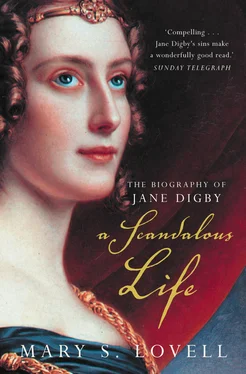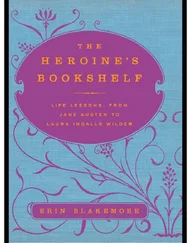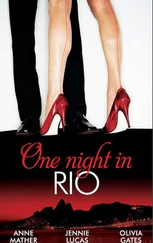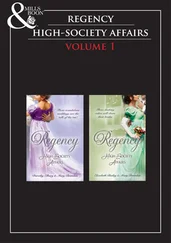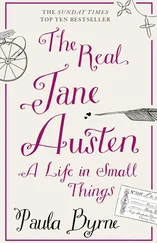Though no longer required in the role of governess, Steely remained as Jane’s duenna, to chaperon her during her forthcoming season when Lady Andover was engaged elsewhere. Miss Jane Steele continued to provide drawing lessons.
Had they been told that Jane would hardly be out of her teens before she would appear in one of the most sensational legal dramas of the nineteenth century, making it impossible for her ever again to live in England; that she would be so disgraced that her doting maternal grandfather Coke would cut her out of his life, and her uncle Lord Digby would cut her brother Edward (heir to the title Lord Digby) out of his will; that she would capture the hearts of foreign kings and princes, but would abandon them to live in a cave as the mistress of an Albanian bandit chieftain; that in middle age she would fall in love and marry an Arab sheikh young enough to be her son, and live out the remainder of her life as a desert princess, the Misses Steele could not possibly have believed it. Yet all those things, and much more, lay in the future for Jane Digby.
Unlike many of her contemporaries, Jane was not a stranger to London. Her parents owned a house on the corner of Harley Street ‘at the fashionable end’, 1 so she would not have arrived wide-eyed at the bustle and noise noted by so many débutantes. However, as a girl who had not yet been brought out into society, the time she had previously spent there would have been very tame.
When not in the schoolroom Jane would spend her days shopping with her mother in the morning, if the weather permitted walking. In the afternoon she might walk in Hyde Park, chaperoned by Steely, and paint in watercolours or practise her music at other times. Jane and her brothers would have eaten informal meals with their parents, but for dinners and parties they would have been banished to the nursery – a far cry from Holkham, where the children often mingled with the adults. In town it was not possible for Jane to walk round to the stables and order her horse to be saddled for an invigorating gallop. It was necessary to appoint a given time for the horse to be brought round to the house, and it would be a solecism if a girl not yet out in society or even one in her first season went for a gallop in the park.
But all this changed when she took London by storm. The change to her life was an intoxicating experience. Now she breakfasted late with her parents and, while she might still shop with her mother in the mornings, it was for clothes and fashionable fripperies for her town wardrobe: new silk gloves or satin dancing slippers, an embroidered reticule for walking out, a domino for a masked rout, white ostrich feathers for her presentation, some ells of white sprigged muslin. Now she attended lessons in the cotillion and the waltz, given by a dancing master under Steely’s watchful eye. Now she rode her neat cover-hack in the park at the fashionable hour of 5 p.m., or rode with her mother in the chaise in Rotten Row, nodding to acquaintances, stopping for a chat with friends. Now the florist’s cart was never away from the door with small floral tributes from admirers.
The years of instruction by Steely at last bore fruit. Jane’s natural ear for languages enabled her not only to infiltrate foreign phrases into her conversation and correspondence – the outward sign of a well-rounded education – but also to converse in Italian, French and German with foreign visitors. All those music lessons that Jane had found a dreary bore were now justified, for after a dinner party she might be called upon to perform for her fellow guests. She was a good pianist, and played the guitar and lute; she also had a sweet singing voice. She acquired a wide repertoire of foreign love songs, which generally delighted her listeners. She was not slow to recognise when she captivated her hearers, and was feminine enough to enjoy doing so. 2
At sixteen, however, Jane was younger than the average débutante and had little experience of life. But she realised quite quickly that what was acceptable behaviour in the country was not so in London. A young lady might never venture abroad alone, on foot without a footman, or on horseback or in a carriage without a groom in attendance. She might, by 1824, have shopped with a girlfriend in Bond Street without raising eyebrows, just; but no lady would be seen in the St James’s area where the gentlemen’s clubs were situated. A young unmarried woman could never be alone with a gentleman unless he was closely related, and, while she might drive with a gentleman approved by her mama in an open carriage in the park, it must be a safe gig or perch phaeton and not the more dashing high-perch phaeton affected by members of the four-horse club, nor the newest Tilbury driven tandem. Either of the latter would have branded a girl as ‘fast’, even with a groom acting as stand-in for a chaperone. At a ball she must not on any account stand up to dance with the same man more than twice. The merest breath of criticism against a girl or her family was enough to prevent her obtaining a voucher from one of the Lady Patronesses of Almack’s. 3
Despite the high standards they set for patrons of Almack’s it would be fair to say that the private lives of most of the Patronesses would not stand close examination, for with one exception they all had famous affaires with highly ranked partners ranging from the Prince Regent himself to several Prime Ministers; however, they maintained a discreet appearance of respectability – a pivot, as it were, between the open licentiousness of the Regency and the rapidly approaching hypocrisy of Victorian morality.
Not to be seen at Almack’s branded one as ‘outside the haul ton ’, so that, in effect, the Patronesses constituted a matriarchal oligarchy to whom everyone bowed, including the revered Duke of Wellington, who was turned away one evening for not wearing correct evening dress. Captain Gronow, the contemporary social observer, wrote: ‘One can hardly conceive the importance which was attached to getting admission to Almack’s, the seventh heaven of the fashionable world. Of the three hundred officers of the Foot-Guards, not more than half a dozen [Captain Gronow was one of those] were honoured by vouchers.’ Almack’s was a hotbed of gossip, rumour and scandal, and the country dances were dull. Matters improved somewhat after Princess Lieven and Lord Palmerston made the waltz respectable, though it was still regarded by many parents as ‘voluptuous, sensational … and an excuse for hugging and squeezing’. 4 Alcoholic drinks were forbidden, and refreshments consisted of lemonade, tea and cakes, and bread and butter.
Why entrance to so prosy a venue should excite such passion, when the London season offered dozens of more exciting and enjoyable occupations every evening, can be explained by the fact that Almack’s was the most exigent marriage market in the Western world, 5 and marriage was what the whole thing was about. It was desirable for a young man of decent background and respectable expectations to attract favourable connections through marriage, and if the wife had a good dowry so much the better. But it was essential for a young woman to contract an eligible match with a man who could provide all the social and financial advantages that she had been reared to take for granted. The lot of an unmarried woman past her youth in that milieu was unenviable – thrown, as it were, on to the charity and tolerance of her relatives. Jane Austen’s heroines exemplify, with a touching contemporary immediacy, the importance of a woman ‘taking’ duringdeher début.
Vast wardrobes of morning dresses, afternoon dresses, walking-out dresses, ballgowns, riding habits and gowns suitable for every conceivable occupation were necessary. But cloaks and gowns were only the start. Accessories, such as collections of hats ranging from the simple chipstraw to high-crowned velvet bonnets, were indispensable. Gloves of silk, lace, satin and kid for every occupation that might be fitted in between rising and retiring, from walking to riding to dining and dancing, were essential. Sandals, reticules, shawls, tippets, fans, chemises, camisoles and undergarments such as stays were obligatory. All of this, with luck, would form the basis of a girl’s trousseau in due course. Further expenditure included the cost of a good horse for riding in Hyde Park (a prime shopwindow in the marriage market) and the use of a carriage, since it was no use expecting a girl to travel everywhere by sedan chair. If the parents had no town-house of their own, and no relative with whom to stay, they must also bear the cost of hiring a house for the season as well as organising several smart dinner parties and soirées, and at least one ball. It was a huge investment, and this can only have served to heighten the pressure on the girl to fix the interest of a suitable man.
Читать дальше
